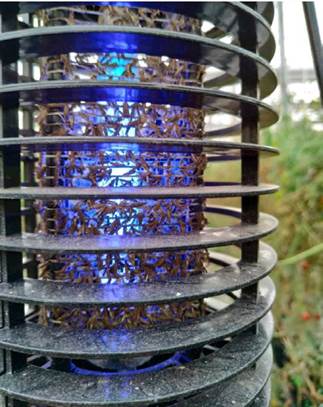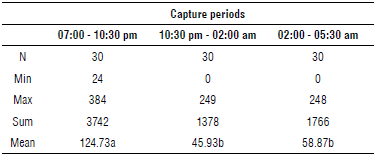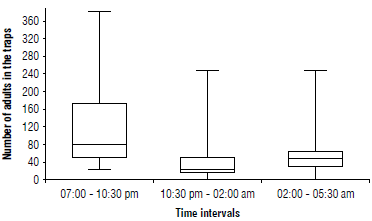Introduction
In the last twenty years there has been a wide proliferation of T. absoluta throughout the world, affecting tomato crops inside greenhouses. Although this pest originated in South America, it has settled around the Mediterranean and in many temperate European countries, including Austria (Gabl & Hausdorf, 2013) and Asian countries, including Nepal (IPPC, 2016), in addition to several African countries much further to the south of the Mediterranean Sea, including Benin (Karlsson et al., 2018). Pesticides have been used for more than a century and have played a relevant role in pest and plant disease control; however, they can lead to environmental imbalances and increase production costs.
Therefore, Integrated Pest Management (IPM) is a strategy that must be adopted by all farmers at every technological level of production (Culliney, 2014).
One of the most usual methods for pest control is genetic resistance. Plants of the species Lycopersicum hirsutum var. hirsutum were used in breeding programs (Azevedo et al., 2003) to induce tomato leafminer -Tuta absoluta (Meyrick)- resistance. Nonetheless, tomato varieties with this kind of resistance are not yet available in the market.
Combined methods in Iran to control T. absoluta in tomato were implemented by Nazarpour et al. (2016). The authors used plant extracts with insecticidal action such as neem (Azadirachta indica), combined with insecticides, entomopathogenic fungi and generalist predators, and attained good results. For this, fungi and bacteria (among other microorganisms, such as virus, nematodes, etc.) are sprayed on biological targets. The fungus Metarhizium anisopliae parasitizes eggs and reduces the reproductive potential of T. absoluta females (Pires et al., 2009). Beauveria bassiana is another fungus that controls T. absoluta larvae, mainly the youngest ones (Silva et al., 2020). Insecticidal proteins, 100 ml/100 L, (e.g. Cry, Cyt and Vip) from bacteria Bacillus thuringiensis var. Kurstaki (BTk), were also applied to control lepidopteran caterpillars (Estruch et al., 1996).
Pheromones are also useful to monitor the presence or absence of a specific pest; however, they tend to capture only one of the adult genera of the pest and generally attract only males of the species. Cocco et al. (2013) verified that the use of pheromones may be a tool to control the mating of T. absoluta in greenhouses since pheromones cause disruption of mating signals. In relation to the use of pheromones, Caparros et al. (2012) reported that females can lay eggs by deuterotokous parthenogenesis under specific conditions. Lee et al. (2014) showed that the occurrence of polyandry explains the failure of control methods based on phero-mones in open greenhouses in some tomato-growing areas.
There are some complementary methods to the use of pesticides in greenhouses. Biological methods, such as the use of parasitoid insects (Amaya, 1988) or predators (Frescata & Mexia, 1996) and predatory mites (Hussey & Scopes, 1985), which are registered in the Brazilian Ministry of Agriculture (MAPA), have not been used on a large scale by Brazilian farmers yet.
A greenhouse makes it difficult not only for most pest insects to enter but also for their natural enemies. Another physical method is the use ofyellow traps covered with glue to attract winged insects and, consequently, kill them (Taha et al., 2012). IPM needs further improvements to avoid the spread of this pest to regions of the planet where it is still absent (Biondi et al., 2018).
The use of ultraviolet light traps to attract and capture Lepidoptera adults inside greenhouses may be a noteworthy method to reduce both pest spread, and the amount of pesticides in tomato crops.
In Brazil, a field experiment on tomato plants on stakes (Oliveira et al., 2008) confirmed that light traps with a combination of black light and "Blue Light Bulb" (ultraviolet) are far more attractive for adults of T. absoluta than white light traps.
Despite some studies addressing the presence, monitoring, and control of T. absoluta in greenhouses (Erler et al., 2010; Nannini et al., 2011), only a few refer to the use of light traps with ultraviolet lamps in these structures (Cocco et al., 2012; Mohammadipour et al., 2019). The results of Cocco et al. (2012) suggested that, at high infestations, the light traps were not efficient, while Mohammadipour et al. (2019) suggested quite the opposite.
Biological studies claim that the mating phase of T. absoluta occurs during the first hour of the photophase, and the mating pairs take from a few minutes to 6 h 40 min to uncouple (Lee et al., 2014). Moreover, they confirm the results of another experiment (Hickel & Vilela, 1991), in which the females mate several times, but only in the early hours of the morning.
This study aimed to test an industrial light trap with ultraviolet lamp and built-in electrical device for the control of adults of T. absoluta in greenhouses and, additionally, to determine the best night capture interval.
Materials and methods
The experiment site was Paty do Alferes (Rio de Janeiro, Brazil), with an altitude of 613 m, in Serra do Mar. It has a tropical climate with periodic rain and a dry winter (Aw) (Köppen, 1948). The average temperature is 20.0°C and there is significant rainfall, with an annual average of 1,637 mm (Paiva & Lopes, 2013).
The experiment took place in the locality known as Coqueiros, on a rural property called Bom Jardim in a greenhouse of 28 x 45 x 7 m area (22°22'19" S, 43°19'51" W), with tomatoes 'Grazianni' of average yield 5-7 kg/plant in 2,860 pots. The Grazianni type tomatoes are a hybrid type of indeterminate growth, with an oblong shape and an average fruit weight of approximately 190 g. The plants were sown on 10/10/2020 and planted permanently in pots on 11/23/2020.
Three mosquito killer traps FIX, composed of metal (built-in electrical device), polypropylene, electronic components and a LED lamp (Black Light 4 W F4T5 BL-UV) (Fig. 1), voltage 110 V, and dimensions of 27 x 12 cm, and a small brush which is part of the piece set were used to attract and trap T. absoluta moths. The experiment lasted a complete lunar cycle (begins and ends with a new moon), from 03/06/2021 until 04/04/2021.
The three light traps were set up at 2.40 m in height in line with the cultivation lines, 1.2 m apart and 11.5 m from the main entrance, in the anteroom of the greenhouse.
The on and off programming of the lighting traps proceeded as follows: the first trap was lit from 07:00 to 10:30 pm; the second from 10:30 pm to 02:00 am of the following day; and the third from 02:00 to 05:30 am. A single light source of attraction was used throughout the night; the three intervals of 3 h and a half each were designed to determine the best night capture interval, if any. To carry out the programming, a Weekly Digital Timer model YDT-MB, bivolt 127-220 v ~ 60 Hz, maximum load 10 A/2.200 W, minimum setting interval of 1 min, and operating temperature between -10°C up to 50°C was used.

FIGURE 1 Mosquito light traps (FIX, Black Light 4 W F4T5 BL-UV) with Tuta absoluta (Meyrick) adults.
Light traps were revised daily in the morning. To separate the specimens attached to the metallic spiral, an appropriate brush belonging to the trap set was used. They were packed in transparent plastic bags and labeled to be counted later.
Phytosanitary treatments and fertilizers
The tomato seeds ('Grazianni') were planted in trays with substrate composed of Sphagnum spp. peat, expanded vermiculite, dolomitic limestone, agricultural plaster, and NPK fertilizer (traces). In the seedling nursery, the seeds received phytosanitary treatments with the fungicides metalaxyl-M + chlorothalonil (300 ml/100 L) and the insecticides: spinosad (10 ml/100 L), thiamethoxam (20 g/100 ml), abamectin (100 ml/100 L) and chlorantra-niliprole (15 ml/100 L).
The seedlings treated were transplanted into pots and treated as follows: two sprayings with dicarboximide (240 g/100 L), copper oxychloride (200 g/100 L) fungicides with an interval of 10 d between them, and one drench with fungicide thiophanate-methyl (90 g/100 L). One irrigation was made with the insecticides thiamethoxam and chlorantraniliprole, one spraying with the insecticide cypermethrin + profenofos (15 ml/100 L) and one with the biological insecticide Bacillus thuringiensis var. Kurstaki (BTk). A drench with commercial compost and a spraying fertilizer rich in amino acids were also applied. Other treatments used were fertilization with calcium, spraying with the insecticide chlorantraniliprole, and watering with a copper-based commercial fertilizer. After 45 d, the biological insecticide (Btk) was sprayed on a weekly basis.
The data obtained were analyzed by the ANOVA test. Treatment means were compared by Tukey's test at 5% probability. For the analysis, the PAST 4.03 (Hammer et al., 2001) software was used.
Results and discussion
During the experiment, 6,886 specimens of T. absoluta were captured using a light trap, with different capture times (Tab. 1). The period of 7:00-10:30 pm was when most (54.3%) adults of T. absoluta were captured, resulting in a statistically significant difference in relation to other periods.
TABLE 1 Univariate analysis for the collection of Tuta absoluta (Meyrick) specimens, using light traps, with different capture periods.

Averages followed by different letters indicate significant statistical differences by the Tukey's test (P≤0.05).
The variation in the number of adults of T. absoluta collected within each capture period, during the performance of the study (Fig. 2), may be attributed to the period of flight activity of T. absoluta. This type of data can be very useful in establishing new population sampling protocols for this pest, thus, improving its control.

FIGURE 2 Comparison of distributions of Tuta absoluta (Meyrick) adults collected at three different capture times. The vertical line in the boxes shows the median, and boxes show 25-75% quartiles, and whiskers show minimal and maximal values.
A better understanding of the period of greatest activity of T. absoluta can improve IPM programs in tomato crops, helping both in the control and monitoring of the tomato moth population, allowing the use of resources according to the fluctuation of the pest.
Nowadays consumers are very concerned about excessive use of pesticides, and producers about the optimization of production expenses and satisfying the demands of the internal and external markets. Picanço et al. (1995) showed that the control of this pest is arduous, even with the intense use of chemical products. The results of this study are of great relevance for IPM programs in tomato crops, since the chemical control methods, applied exclusively, did not show efficiency for the control of Tuta absoluta.














